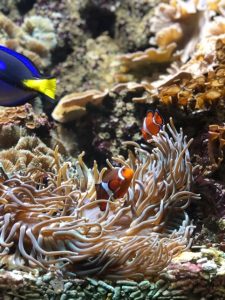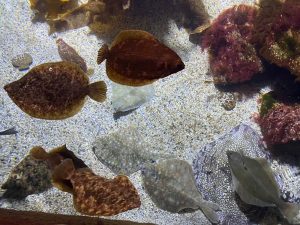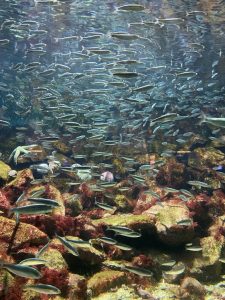
Us students enjoying our stay at the Bergen Aquarium (from left: Linn Elise Dodderma, Eugenie Westerling, Ingvild Riska, Hjörtur Methúsalemsson, Bylgja Sif Jónsdóttir, Catharina Olsen, Mari Munkeby, Olina Skorá and Antonio Motos)
Photo: Leif Nøttestad
Authors with equal contribution: Linn Elise Doddema, Mette Espedal, Bylgja Sif Jónsdóttir, Sigrid Kjelstad, Hjörtur Methúsalemsson, Antonio Motos, Mari Munkeby, Catharina Olsen, Ingvild Riska, Olina Skorá, Eugenie Westergerling
There are about 54.000 known vertebrate animal species, which are those having a backbone of spiral column, including mammals, birds, reptiles, amphibians, and fishes. The world’s oceans are home to more than 20.000 fish species and nearly 40% of all vertebrates. They come in all shapes, sizes, and colours, and live in drastically different depths and temperatures. There are thousands of billions of fish swimming around and some of these fascinating creatures live at Bergen Aquarium. In the course BIO324 Fish Behaviour, we travelled far and wide to study fish behaviour on an excursion in one of the most visited places in Norway. The aim was to apply what we have learned from teaching in the classroom, by practical studies and observations of the diverse behaviours displayed in the water-filled tanks. Behaviour is something we all unconsciously register and respond to every single day, both among our own species and others. What is the point of actually studying behaviour, especially among fish that few of us rarely interact with on a daily basis? And what could we possibly use this knowledge for?
Wandering between the abundance of fish, something caught our eyes. We almost missed it, stuffed in a dark corner beside the colourful water-tunnel, but there they were: Nemo and his quirky friend Dory. As we came closer, Nemo, or the Clownfish (Amphiprioninae) to be more scientific, quickly retreated into the venomous anemone (Figure 1). Dory (Blue Tang, Paracanthurus hepatus) on the other hand, seemingly oblivious to our presence, just kept swimming. But why would Nemo prefer the stinging anemone to our gawking overly-excited faces? This is actually a perfect example of a natural occurring relationship between the fish and anemone. The anemone provides protection from predators with their unpleasant venomous cells, which the clownfish is immune to. And in return, the fish cleans the anemone of parasites and stimulates its growth by providing nitrogen and better water circulation.

Figure 1: Clownfish interacting with the anemone. Photo: Linn Elise Doddema
Following our fascinating journey around the aquarium, we were eager to document the weird-looking organisms by taking pictures. Have you ever wondered why aquaria, zoos, and other wildlife parks forbid you from using flash when taking photos? The possible impacts of flash photography are a frequently discussed topic in animal welfare and ethics, but little investigation was done to investigate the effects of photography on fish. During our excursion to the aquarium, we tested the hypothesis that fish would react to the camera flash of a Sony a6000. Contrary to our expectations, only two out of 13 species showed changes in their behaviour. Retroculus xinguensis swam a couple of centimetres away from the source of lights and froze for some time in their swimming behaviour (Figure 2). The Pinktail triggerfish (Melichthys vidua) displayed a more active swimming behaviour while being flashed. Two additional species seemed to react with some lag in time to the flash, however it is unsure if this was simply a normal change in swimming behaviour or a behaviour induced by the flash. The remaining 9 species did not show any indication of changing their swimming behaviour in response to the stimulus. So why don’t the fish react?
Firstly, fish are aquatic species and water has higher density than air which makes it difficult to look very far. This becomes even more difficult when the water is turbid or murky. Therefore, fish are much better at listening than at seeing. Secondly, fish in aquaria are used to the presence of people talking, tapping on the window, and taking photos, and may therefore not react to the flash. By studying fish behaviour to understand how they interact with their surroundings, we can use this knowledge to understand how they learn and react to stressors. This can be useful in conservation, sustainable fishing, environmental impact studies and tourism.

Figure 2: On the left, Retroculus xinguensis and on the right the Pinktail triggerfish, both being photographed with flash. Photo: Eugenie Westergerling
Another particular behaviour was observed in the flatfish aquarium, specifically in the area where the fish is fed. The flatfish approached us by swimming to the surface, which was unexpected since this fish is known as a “sit-and-wait predator” (Figure 3). This could be explained by a cognition process in fish called associative learning. In this case, the flatfish probably has learned to associate the presence of people above the aquarium with feeding. This learning is of the type classical conditioning, where the animal has learned to associate a neutral stimulus with an event.

Figure 3: Flatfish approaching the surface. Photo: Ingvild Riska
The journey ended in front of the miraculous Atlantic herring (Clupea harengus) aquarium. If you see fish in groups swimming around in circles, appearing to act as a single organism, you are witnessing what is called schooling behaviour. In the sea, fish use schooling to protect themselves from predators. They use their lateral line to feel the others in the group and swim in unison as they are safer within the group. If the danger of predation rises, the closer and faster the fish swim together to avoid being eaten. An excellent example of schooling can be seen in the Atlantic Herring. In the aquarium we saw a herring cage that somehow mimics their natural habitat, where all the fish swam quite slowly in a big group in the middle of the cage; all in the same direction but with plenty of space between each individual (Figure 4). Sometimes a few fish swam out of the group as something caught their attention. Since they are used to humans, we thought that they would not acknowledge us being there. As we came closer to those individuals and made quick movements, they reacted to us by flinching and swimming straight back into the school again. The rest of the school did not react since the disturbance was not big and only stationary. When we stopped moving for some time, some fish started to swim out of the school again. The circular movement in the cage might also be connected to their feeding, as they know that they are fed and don’t need to find food or fight for it; therefore they might be swimming relaxed in circles waiting for the food to arrive. It could also be connected to the small space they have in the cage, as they might would have showed a different behaviour in the open ocean.

Figure 4: Schooling behaviour in Atlantic herring. Photo: Hjörtur Methúsalemsson.
So, what is the point of being curious about the behaviour observed in Bergen Aquarium? Humans have depended on freshwater and marine habitats since the early days of our species. We have studied fish behaviour for thousands of years, long before it was considered the scientific field that it is today. From early on, we started learning about their life history traits and movements to find efficient ways to hunt them, and to mend equipment to trap them. Only after a few hours in the aquarium, we observed how the clownfish relies on anemones for protection, how flashing lights might induce stress, how fish are able to habituate being taken pictures of, and how some species enjoy the company of others in schools. These observations are important to acknowledge and further understand the vast ocean and the species that live within.
Observations like these have improved our knowledge, and further examination in the future can be used to our advantage. For humans to be able to fish, it is important to know how the fish behave, how they interact with their ecosystem and other species, when and where to fish and what kind of equipment works on each species. If humans were not able to fish, we would be in a lot of trouble since fish is vital in our survival. As well as being able to fish, we need to be aware not to overfish the species. In addition, behaviour like migratory routes, choice of feed and predator-prey interactions can tell us a great deal about the environmental conditions in the ocean. Therefore, fish behaviour is important for management purposes involving spawning behaviour, recruitment, feeding and condition of fish stocks, migration and environmental monitoring; to obtain healthy conservation as well as exploitation of fish species. The more you know about fish behaviour, the cleverer you will be at sustainable fishing, environmental conditions, climate variations and of course the habits of the weird and diverse creatures lurking in the sea.
